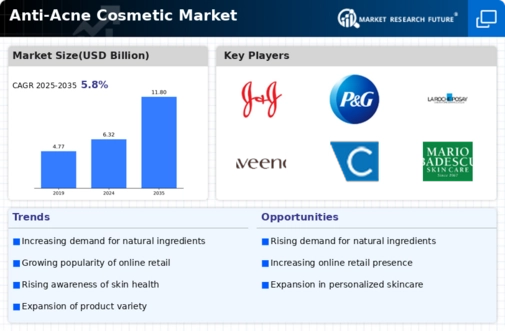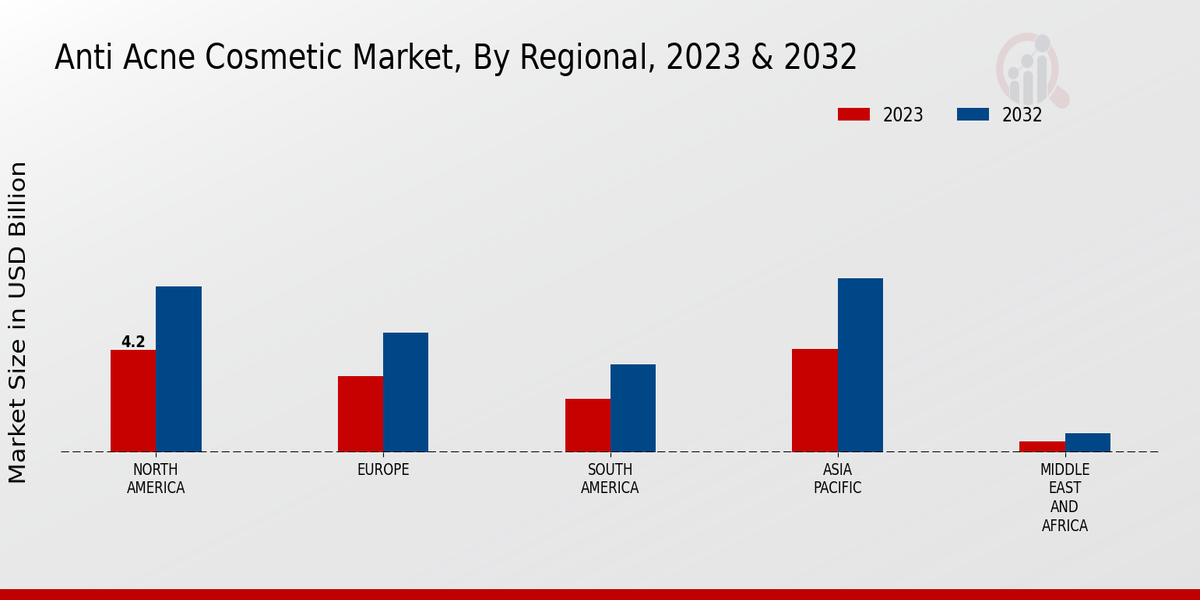Market Growth Projections
The Global Anti-Acne Cosmetic Market Industry is poised for substantial growth, with projections indicating a market size of 6.32 USD Billion in 2024 and an anticipated increase to 11.8 USD Billion by 2035. This growth trajectory suggests a robust demand for anti-acne products, driven by factors such as rising acne prevalence and increasing consumer awareness. The expected CAGR of 5.83% from 2025 to 2035 further underscores the market's potential. Such figures reflect a dynamic landscape where innovation and consumer preferences are likely to shape the future of anti-acne cosmetics.
Rising Prevalence of Acne
The increasing incidence of acne among various age groups drives the Global Anti-Acne Cosmetic Market Industry. Statistics indicate that approximately 85 percent of individuals aged 12 to 24 experience acne at some point in their lives. This widespread occurrence has led to a heightened demand for effective anti-acne products. As awareness around skin health continues to grow, consumers are actively seeking solutions that can address their concerns. The market is projected to reach 6.32 USD Billion in 2024, reflecting the urgency for innovative formulations that cater to diverse skin types and conditions.
Growing Awareness of Skincare
There is a notable surge in consumer awareness regarding skincare, particularly concerning acne treatment, which propels the Global Anti-Acne Cosmetic Market Industry. Educational campaigns and social media influence have significantly contributed to this trend, encouraging individuals to prioritize skincare routines. As a result, consumers are increasingly inclined to invest in specialized anti-acne products that promise efficacy and safety. This trend is expected to sustain growth, with the market anticipated to expand to 11.8 USD Billion by 2035. The emphasis on preventive care and proactive skincare regimens underscores the evolving landscape of consumer preferences.
Expansion of E-commerce Platforms
The rapid growth of e-commerce platforms is reshaping the Global Anti-Acne Cosmetic Market Industry. Online shopping offers consumers convenience and access to a wider range of products, including niche and specialized anti-acne solutions. This trend has been accelerated by the increasing penetration of smartphones and internet connectivity globally. E-commerce not only facilitates direct-to-consumer sales but also allows brands to engage with their audience through targeted marketing strategies. As a result, the market is expected to witness substantial growth, aligning with the overall trend of digital transformation in retail.
Technological Advancements in Formulations
Innovations in cosmetic formulations are transforming the Global Anti-Acne Cosmetic Market Industry. Advances in dermatological science have led to the development of new ingredients and delivery systems that enhance product effectiveness. For instance, the incorporation of probiotics and botanical extracts has gained traction, appealing to consumers seeking natural alternatives. These advancements not only improve product performance but also cater to the growing demand for clean beauty. As the market evolves, brands that leverage cutting-edge technology are likely to capture a larger share, contributing to a projected CAGR of 5.83% from 2025 to 2035.
Influence of Social Media and Celebrity Endorsements
The impact of social media and celebrity endorsements on consumer behavior is profound, particularly in the Global Anti-Acne Cosmetic Market Industry. Platforms like Instagram and TikTok serve as powerful marketing tools, where influencers showcase their skincare routines and recommend products. This trend has led to increased visibility for various anti-acne brands, driving sales and brand loyalty. As consumers increasingly rely on peer reviews and influencer recommendations, companies are adapting their marketing strategies to capitalize on this phenomenon. The result is a dynamic marketplace where engagement and authenticity play crucial roles in shaping consumer choices.

















